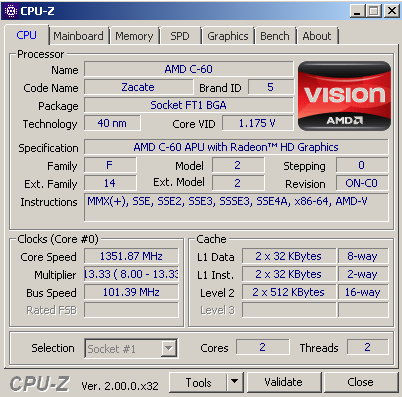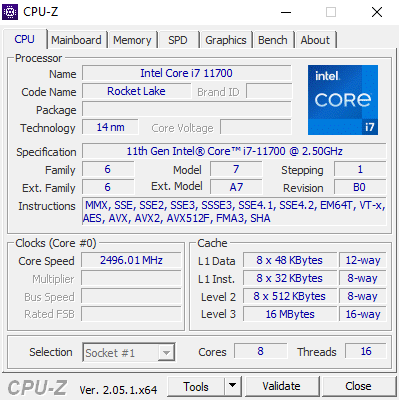Comparing: AMD C-60 vs Intel Core i7 11700
In this comparison, we analyze two Processors: AMD C-60 and Intel Core i7 11700, using synthetic benchmark tests to evaluate their overall performance. This side-by-side comparison helps users understand which hardware delivers better value, speed, and efficiency based on standardized testing. Whether you're building a new system or upgrading an existing one, this benchmark-driven evaluation offers valuable insights to guide your decision.
Specification Comparison Table
This specification comparison presents technical details of several devices or components to help you understand the key differences between each option. Use this table as a reference to determine which device best suits your needs.
| Specification | AMD C-60 | Intel Core i7 11700 |
|---|---|---|
| Architecture | x86 | x86 |
| Technology | 40 nm | 14 nm |
| Clock | 1 GHz - 1.3 GHz | 2.5 GHz - 4.9 GHz |
| Core/Thread | 2 / 2 | 8 / 16 |
| Segmen | Mobile | Desktop |
Submission Comparison Table
This submission comparison table displays the number and details of benchmark data submissions from various devices or components. This information helps you understand the performance based on the benchmarks that have been tested, as well as providing an overview of the consistency and popularity of the available benchmark results.
| No. | Benchmark Software | AMD C-60 | Intel Core i7 11700 |
|---|---|---|---|
| 1 | PiFast |
2min, 14sec, 820ms |
12sec, 510ms |
| 2 | SuperPi - 1M |
1min, 139ms |
6sec, 921ms |
Submission Comparison Chart
This chart visualizes the benchmark scores comparison between two hardware devices based on submitted data.
Media Gallery
A collection of photos of tested hardware. These images can help you identify the physical form, model, and variant of the hardware in question. These photos are from our own documentation, and if they are not available we may not be able to document them.
About Hardware AMD C-60
Released in 2011, the AMD C-60 is a power-efficient processor from the Ontario series built on the Bobcat architecture. It has 2 cores and 2 threads, with a base speed of 1.0 GHz that can be increased to 1.33 GHz through Turbo Core technology. Designed specifically for portable devices such as netbooks and ultraportable laptops, the C-60 is focused on power efficiency and long battery life rather than high performance. With a TDP of just 9 watts, this processor enables ultra-thin and lightweight laptop designs without the need for complex active cooling systems. The main advantage of the C-60 is its extremely low power consumption, making it an attractive solution for users who need a lightweight computing device for daily activities with high mobility.
The AMD C-60 is also equipped with an integrated Radeon HD 6290 GPU, which has 80 shader cores and supports DirectX 11. Despite its modest specifications, this GPU is sufficient for multimedia purposes such as HD video playback, light graphics rendering, and old-school games with minimal graphics settings. However, overall, the performance of the AMD C-60 is limited and only suitable for light tasks such as browsing, typing documents, and using basic office applications. This processor will feel slow when used for heavy multitasking, modern software installation, or complex web-based applications. In tests using an Acer Aspire One 522 paired with 2GB DDR3 RAM and Windows 7 operating system, the processor was able to provide a decent user experience for basic needs, but was less responsive when compared to mainstream processors of the same generation. Even so, the AMD C-60 remains a viable solution for low-cost, power-efficient devices of its time.
Hardware Detail:
Device: Acer Aspire One 522
RAM: 2GB DDR3
OS: Windows 7
Friday, 08 April 2022 17:00:00 | Update: 1 month ago
About Hardware Intel Core i7 11700
The Intel Core i7-11700 is a powerful desktop processor released in Q1 2021, as part of Intel’s 11th Generation Rocket Lake family. Designed for enthusiasts, gamers, and content creators, this CPU offers a solid balance of single-threaded and multi-threaded performance. It features 8 physical cores and 16 threads, making it ideal for tasks such as gaming, streaming, 4K video editing, 3D rendering, and heavy multitasking.
With a base clock speed of 2.5 GHz and a maximum turbo frequency of up to 4.9 GHz, the i7-11700 delivers strong performance out of the box. The processor is built on Intel’s 14nm process node, but with significant architectural improvements over the previous generation, notably higher IPC (Instructions Per Cycle) thanks to the Cypress Cove core design. Despite using the older 14nm process, these architectural upgrades allow the i7-11700 to compete closely with AMD's Ryzen 7 5000-series CPUs in many workloads.
The TDP (Thermal Design Power) of the Core i7-11700 is rated at 65W, making it relatively efficient for a high-end CPU. However, under sustained heavy loads, especially in systems with aggressive power limits or PL1/PL2 settings, actual power consumption can be much higher—so a decent cooling solution is recommended for consistent performance.
For integrated graphics, the i7-11700 is equipped with Intel UHD Graphics 750, based on the Xe architecture. It supports up to 4K resolution at 60Hz, HEVC/VP9 decode/encode, and can handle light gaming or display output without the need for a discrete GPU. Still, for users focused on gaming or GPU-accelerated workloads, pairing this processor with a dedicated graphics card is highly recommended.
Hardware Detail:
Device: Dell OptiPlex 5090
CPU: i7-11700
RAM: 32GB
OS: Windows 10
Monday, 05 June 2023 13:51:38 | Update: 1 month ago




